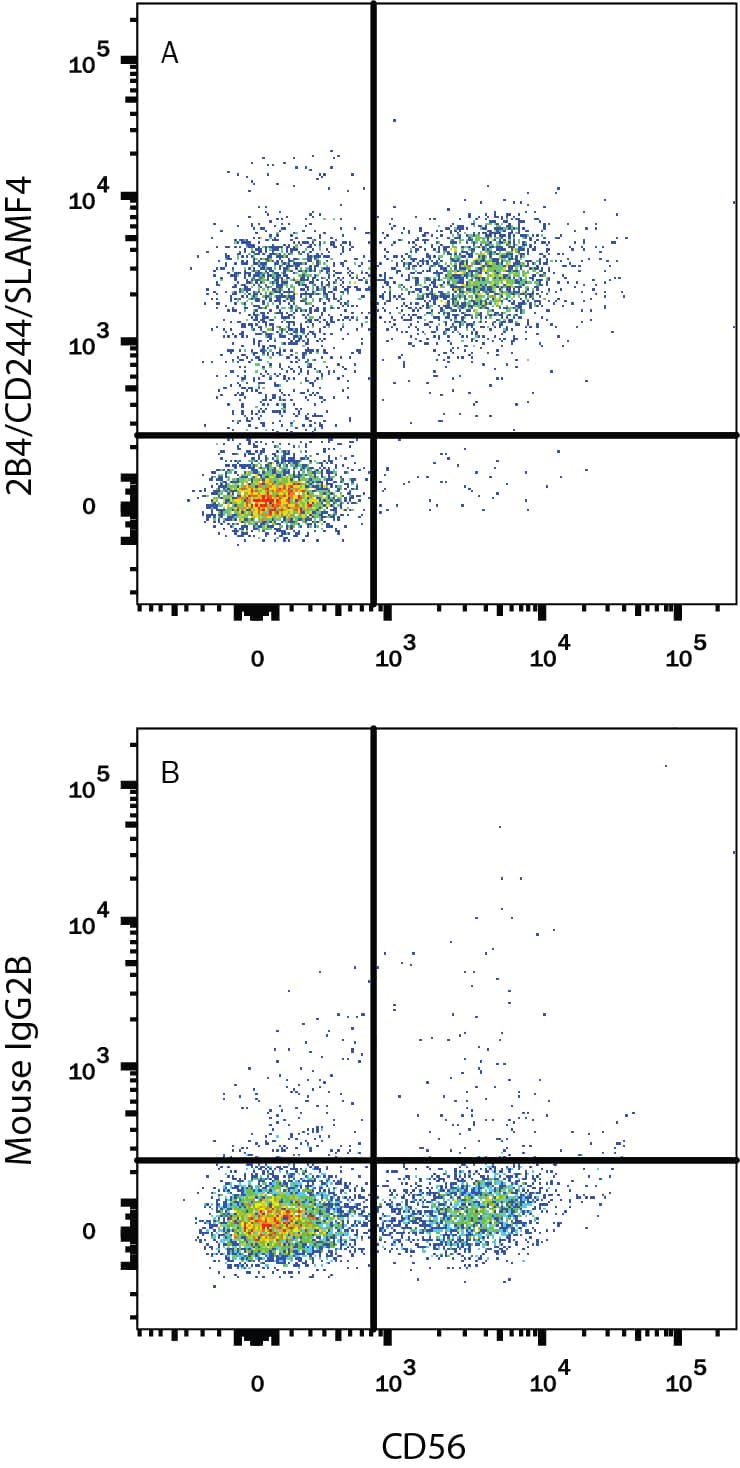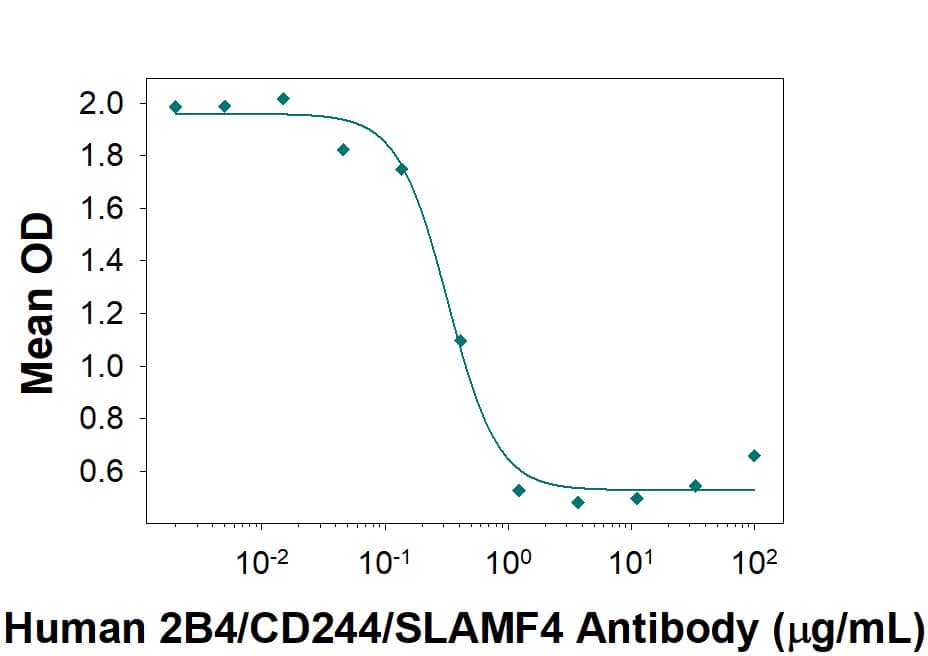Human 2B4/CD244/SLAMF4 Antibody
R&D Systems, part of Bio-Techne | Catalog # MAB10393


Key Product Details
Species Reactivity
Applications
Label
Antibody Source
Product Specifications
Immunogen
Gly19-His222
Accession # NP_057466
Specificity
Clonality
Host
Isotype
Endotoxin Level
Scientific Data Images for Human 2B4/CD244/SLAMF4 Antibody
Detection of 2B4/CD244/SLAMF4 in HEK293 Human Cell Line Transfected with Human 2B4/CD244/SLAMF4 and eGFP by Flow Cytometry.
HEK293 human embryonic kidney cell line transfected with (A) Human 2B4/CD244/SLAMF4 and eGFP or (B) irrelevant protein, was stained with Mouse Anti-Human 2B4/CD244/SLAMF4 Monoclonal Antibody (Catalog # MAB10393) followed by Allophycocyanin-conjugated Anti-Mouse IgG Secondary Antibody (Catalog # F0101B). Quadrant markers were set based on Mouse IgG2B isotype control antibody staining (Catalog # MAB0041). View our protocol for Staining Membrane-associated Proteins.Detection of 2B4/CD244/SLAMF4 in HEK293 Human Peripheral Blood Lymphocytes by Flow Cytometry.
Human peripheral blood lymphocytes were stained with (A) Mouse Anti-Human 2B4/CD244/SLAMF4 Monoclonal Antibody (Catalog # MAB10393) or (B) Mouse IgG2B isotype control antibody (Catalog # MAB0041) followed by PE-conjugated Anti-Mouse IgG Secondary Antibody (Catalog # F0102B) and Mouse anti-Human CD56 APC-conjugated Monoclonal Antibody (Catalog # FAB2408A). View our protocol for Staining Membrane-associated Proteins.CD48/SLAMF2 Binding to 2B4/CD244/SLAMF4 Blocked by Human 2B4/CD244/SLAMF4 Antibody.
In a functional ELISA, 100-500 ng/mL of this antibody will block 50% of the binding of 400 ng/mL of Recombinant Human CD48/SLAMF2 (Catalog # 3644-CD) to immobilized Recombinant Human 2B4/CD244/SLAMF4 Fc Chimera (Catalog # 1039-2B) coated at 5 ug/mL (100 µL/well). At 10 ug/mL, this antibody will block >90% of the binding.Applications for Human 2B4/CD244/SLAMF4 Antibody
Blockade of Receptor-ligand Interaction
CyTOF-ready
Flow Cytometry
Sample: HEK293 Human Cell Line Transfected with Human 2B4/CD244/SLAMF4 and eGFP and Human Peripheral Blood Lymphocytes
Formulation, Preparation, and Storage
Purification
Reconstitution
Formulation
Shipping
Stability & Storage
- 12 months from date of receipt, -20 to -70 °C as supplied.
- 1 month, 2 to 8 °C under sterile conditions after reconstitution.
- 6 months, -20 to -70 °C under sterile conditions after reconstitution.
Background: 2B4/CD244/SLAMF4
2B4, also known as CD244 and SLAMF4, is a 66 kDa type I transmembrane glycoprotein in the SLAM subgroup of the CD2 protein family. SLAM family proteins have an extracellular domain (ECD) with two or four Ig-like domains and at least two cytoplasmic immunoreceptor tyrosine-based switch motifs (ITSMs). 2B4 interacts with CD48, while other SLAM family proteins interact homophilically (1‑4). Mature human 2B4 consists of a 208 amino acid (aa) ECD with two Ig-like domains, a 21 aa transmembrane segment, and a 120 aa cytoplasmic domain with four ITSMs (5, 6). Three additional splice variants of human 2B4 have deletions of the short region between the Ig-like domains, the second Ig-like domain, or a portion of the cytoplasmic tail. Within the ECD, human 2B4 shares 46% and 40% aa sequence identity with mouse and rat 2B4, respectively. The ECD of human 2B4 shares 17%‑24% aa sequence identity with comparable regions of human CD2 family members BLAME, CD2F-10, CD84, CD229, CRACC, NTB-A, and SLAM. 2B4 is expressed on all NK cells, gamma delta T cells, monocytes, some CD4+ and CD8+ T cells, and some dendritic cells (7). CD48 mediates 2B4+ cell interactions with nearly all hematopoietic cell types, including cells of the same type (8‑10). 2B4/CD48 signaling cooperates with other receptor systems to either promote or inhibit NK and CD8+ T cell activation (7‑13). The inhibitory activities are distinct from those of MHC I restricted inhibitory NK cell receptors (12, 13). Ligation of 2B4 with antibodies or CD48 constructs can either directly trigger inhibitory signaling or disrupt an inhibitory interaction, leading to cellular activation (9, 12). The inhibitory effect is associated with the long form of 2B4, while the activation is associated with the short form (9, 14). 2B4 can also induce signaling through CD48 (10, 15).
References
- Bhat, R. et al. (2006) J. Leukoc. Biol. 79:417.
- Veillette, A. (2006) Nat. Rev. Immunol. 6:56.
- McNerney, M.E. et al. (2005) Mol. Immunol. 42:489.
- Assarsson, E. et al. (2005) J. Immunol. 175:2045.
- Boles, K.S. et al. (1999) Tissue Antigens 54:27.
- Kubin, M.Z. et al. (1999) Eur. J. Immunol. 29:3466.
- Nakajima, H. et al. (1999) Eur. J. Immunol. 29:1676.
- Lee, K.M. et al. (2006) Blood 107:3181.
- Mooney, J.M. et al. (2004) J. Immunol. 173:3953.
- Assarsson, E. et al. (2004) J. Immunol. 173:174.
- Bryceson, Y.T. et al. (2006) Blood 107:159.
- Lee, K-M. et al. (2004) J. Exp. Med. 199:1245.
- McNerney, M.E. et al. (2005) Blood 106:1337.
- Schatzle, J.D. et al. (1999) Proc. Natl. Acad. Sci. USA 96:3870.
- Messmer, B. et al. (2006) J. Immunol. 176:4646.
Alternate Names
Gene Symbol
UniProt
Additional 2B4/CD244/SLAMF4 Products
Product Documents for Human 2B4/CD244/SLAMF4 Antibody
Product Specific Notices for Human 2B4/CD244/SLAMF4 Antibody
For research use only

